Do you have a question about the DeWalt D55155 and is the answer not in the manual?
Identifies major parts like switches, gauges, regulator, and filter.
Defines DANGER, WARNING, CAUTION for hazard communication.
Covers risks from sparks, flammable vapors, and unsafe air.
Hazards related to oil leaks and improper handling during transport/storage.
Details on preventing air tank failure due to corrosion or modification.
Precautions to prevent electric shock from the compressor.
Warnings about injury from propelled particles in the air stream.
Alerts to burns from hot parts and injury from moving components.
General safety rules for operating the compressor responsibly.
Risks of falling and potential hearing damage from noise.
Description of essential operational features like switches and valves.
Explains the purpose of gauges, the regulator, and drain/quick connect valves.
Covers pump, motor protector, air filter, and initial hose installation.
Safe methods for attaching and detaching air hoses.
Essential steps for ensuring proper electrical grounding.
Instructions on using the correct DEWALT synthetic oil.
Advice on extension cords and accessory compatibility.
Recommendations for compressor placement and noise reduction.
Safety advice for electrical connections and transporting the unit.
Steps for initial setup and the critical break-in process.
Instructions for starting, using, and shutting down the compressor.
General guidelines for performing maintenance tasks.
Schedule for maintenance and procedure for checking the safety valve.
Steps for inspecting the air filter and draining the air tank.
Procedures for draining condensate and its proper disposal.
Instructions for monitoring and replacing compressor pump oil.
Details on accessories, service requirements, and warranty information.
Definitions for CFM, SCFM, PSI, kPa, and Code Certification.
Explanations of Cut-In Pressure, Cut-Out Pressure, Branch Circuit, and Duty Cycle.
Lists common malfunctions and their associated diagnostic codes.
Details potential causes and corrective actions for compressor issues.
Solutions for problems related to loose fittings, tank defects, seals, and valves.
Addresses regulator adjustment, air usage, and hose-related issues.
Solutions for damaged regulators, humid conditions, and filters.
Troubleshooting pump oil, motor overload, electrical connections, and component defects.
Solutions for tripped breakers, blown fuses, and pressure switch malfunctions.
Identifies major parts like switches, gauges, regulator, and filter.
Defines DANGER, WARNING, CAUTION for hazard communication.
Covers risks from sparks, flammable vapors, and unsafe air.
Hazards related to oil leaks and improper handling during transport/storage.
Details on preventing air tank failure due to corrosion or modification.
Precautions to prevent electric shock from the compressor.
Warnings about injury from propelled particles in the air stream.
Alerts to burns from hot parts and injury from moving components.
General safety rules for operating the compressor responsibly.
Risks of falling and potential hearing damage from noise.
Description of essential operational features like switches and valves.
Explains the purpose of gauges, the regulator, and drain/quick connect valves.
Covers pump, motor protector, air filter, and initial hose installation.
Safe methods for attaching and detaching air hoses.
Essential steps for ensuring proper electrical grounding.
Instructions on using the correct DEWALT synthetic oil.
Advice on extension cords and accessory compatibility.
Recommendations for compressor placement and noise reduction.
Safety advice for electrical connections and transporting the unit.
Steps for initial setup and the critical break-in process.
Instructions for starting, using, and shutting down the compressor.
General guidelines for performing maintenance tasks.
Schedule for maintenance and procedure for checking the safety valve.
Steps for inspecting the air filter and draining the air tank.
Procedures for draining condensate and its proper disposal.
Instructions for monitoring and replacing compressor pump oil.
Details on accessories, service requirements, and warranty information.
Definitions for CFM, SCFM, PSI, kPa, and Code Certification.
Explanations of Cut-In Pressure, Cut-Out Pressure, Branch Circuit, and Duty Cycle.
Lists common malfunctions and their associated diagnostic codes.
Details potential causes and corrective actions for compressor issues.
Solutions for problems related to loose fittings, tank defects, seals, and valves.
Addresses regulator adjustment, air usage, and hose-related issues.
Solutions for damaged regulators, humid conditions, and filters.
Troubleshooting pump oil, motor overload, electrical connections, and component defects.
Solutions for tripped breakers, blown fuses, and pressure switch malfunctions.
The DEWALT D55151, D55152, D55153, and D55155 are Contractor's Electric 4 Gallon Hand Carry Air Compressors designed for various pneumatic applications. These portable units are built for ease of transport and use in different work environments, from job sites to workshops.
The primary function of these air compressors is to convert electrical power into kinetic energy in the form of pressurized air. This compressed air is then stored in a 4-gallon air tank and can be used to power a variety of air tools and accessories, such as nail guns, spray guns, and inflators. The compressor features a pump that draws in ambient air, compresses it, and delivers it to the air tank. A pressure switch automatically controls the motor, starting it when the tank pressure drops below a set "cut-in" pressure and stopping it when it reaches the "cut-out" pressure, ensuring a consistent supply of compressed air. A pressure release valve automatically releases air from the compressor head and outlet tube when the unit reaches cut-out pressure or is shut off, allowing the motor to restart freely. A safety valve acts as a crucial safety mechanism, protecting against over-pressurization by popping out if the pressure switch fails to shut off the compressor at its cut-out setting. The check valve ensures that compressed air remains in the tank when the compressor reaches cut-out pressure.
These air compressors are designed for user-friendly operation. An On/Off switch allows for easy power control, providing automatic power to the pressure switch when in the "ON" position and removing power at the end of each use. The air tank pressure gauge displays the reserve air pressure within the tank, while the regulated pressure gauge shows the air pressure available at the outlet side of the regulator. The pressure regulator allows users to adjust the output air pressure to match the requirements of their specific air tools and accessories. Turning the regulator knob clockwise increases pressure, and counterclockwise decreases it. For enhanced versatility, some models are equipped with universal quick connect bodies that accept three popular styles of quick connect plugs (Industrial, Automotive, and ARO), enabling simple and easy one-hand push-to-connect operations. The availability of two quick connect bodies on some units allows for the simultaneous use of two tools, increasing productivity. The compressor's compact, hand-carry design makes it highly portable, facilitating movement around job sites or between different work areas. When transporting the unit in a vehicle, it is crucial to ensure the tank is drained and the unit is secured to prevent tipping and potential damage. For moving the compressor short distances, it should be grasped by the handle and carried close to the body to maintain balance.
Regular maintenance is essential to ensure the longevity and safe operation of the air compressor. The unit includes an air tank drain valve located at the base of the air tank, which is used to drain condensed water daily or after each use. This prevents rust and thinning of the steel air tank, which could lead to rupture. The compressor pump oil level can be checked using the pump oil dipstick, which indicates the amount of oil in the pump. Regular oil checks and changes are necessary, with the first oil change recommended after 20 hours of operation, and subsequent changes annually or every 200 hours when using DEWALT synthetic compressor oil. The air intake filter is designed to clean the air entering the pump, and it must be kept clean and free from obstructions to ensure a clean, cool, and dry air supply. The filter element should be inspected weekly and cleaned or replaced as needed. The compressor also features a manual thermal overload protector for the motor. If the motor overheats, this protector will shut off the motor, requiring it to cool down before restarting by depressing the reset button. The cooling system, which expels air through vent holes, helps maintain optimal operating temperature. Regular checks for air leaks using soapy water solution around joints are recommended, as well as inspecting the safety valve to ensure it operates freely. The exterior of the compressor should be cleaned regularly to prevent dirt buildup. Any repairs or service operations not explicitly covered in the manual should be performed by a DEWALT factory service center or an authorized service center.
| Tank Capacity | 4.5 Gallons |
|---|---|
| Power Source | Electric |
| Pump Type | Oil-Free |
| Horsepower | 1.6 HP |
| Voltage | 120V |
| Amperage | 15 Amps |
| Type | Portable |
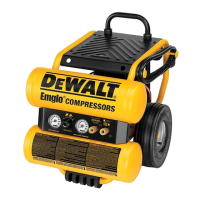
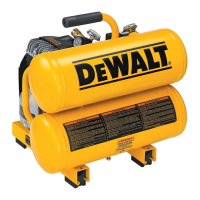
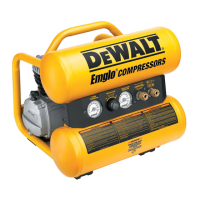
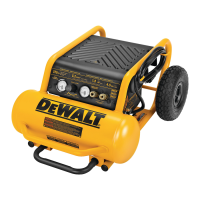
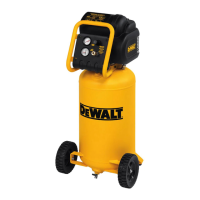
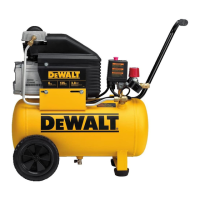
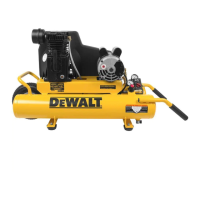
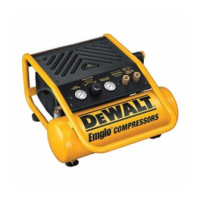
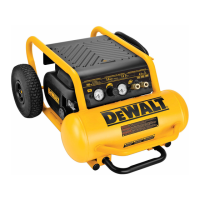
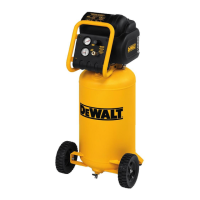
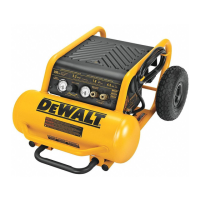
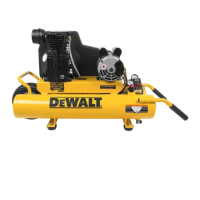
